crash kayo zamm splatt

Would it shock you to know that despite having created one hundred and fifteen (and counting) Perl Advent Calendar entries over the years, I've never written an article on one of the smallest, silliest, modules that I rely on every day? A module that I can't debug my code without?
And the name of that module? Acme::MetaSyntactic. Yes, that's right. An Acme module, from the namespace on the CPAN that's traditionally reserved for joke modules. I'd better explain why I rely so heavily on one of these, shouldn't I?
There was a time when, like a chump, I'd write statements like this throughout my code:
print STDERR "Here!\n";And
print STDERR "Got Here Also!\n";This poor man's debugger technique is surprisingly effective. Unlike a real debugger it works well with web applications, it doesn't require an external module support (so in a pinch you can even use it on one of the production servers you've temporarily stopped the load balancer sending live traffic to) and can be left unattended to generate output on minutes long scripts while you go and fetch a hot beverage.
So if this is so effective, why was I a chump for using it? All that typing. Having to come up with unique new strings to print out all the time...I can't tell you the number of times I'd copy and pasted a print STDERR "Here!" from one place to another and then scratched my head wondering which Here was printing.
Laziness is one of the virtues of a Perl programmer. Surely we can automate this? You bet we can.
Acme::MetaSyntactic is a module that can create random memorable strings for us and the Acme-MetaSyntactic-Themes distribution on the CPAN contains a vast range of themes for it. For example, using the gems theme:
use Acme::MetaSyntactic qw(gems);
say join ' ', metagems(3) for 1..5;Produces output like so:
ruby amethyst girasol
moonstone ivory sugilite
jadeite tiger_s_eye jasper
beryl lapis_lazuli diamondWe can easily use this technique to write a tiny little Perl script that outputs a print statement that contains unique-ish strings
use Acme::MetaSyntactic qw(batman);
say 'print STDERR "'. join(q{ }, metabatman(2)) . '";\\n';Executing this we can see our print statement with awesome 60s Batman type sound effects.
print STDERR "wham_eth klonk\n";But how do we automate inserting this in our Perl code?
Configuring Your Editor
Modern editors are amazing things, Turing complete little bundles of wonder that can be configured to do almost anything, including executing a shell script and inserting the output of the script into your source code.
I won't tell you what editor to use (and you emacs and vim users probably know how to do this already) but I'll let you in on the secret of how I do this with Sublime Text 3, my editor of choice.
Sublime Text 3 has a complex plug-in system written in Python in which I've written many a tool. But, fear not, I need not concern myself with a non-Perl language in this Advent Calendar entry, for many existing plug-ins that can shell out exist that can be installed with Package Control without having to write a line of code. Using the External Command plug-in we can get our script to insert at the cursor every time we hit alt-shift-b.
{
"keys": ["alt+shift+b"],
"caption": "print STDERR meta batman",
"command": "insert_command_output",
"args": { "cmdline": "/Users/mark/bin/printmetabatman" }
}Configuring Your Terminal Emulator
So, why isn't running this in an editor sufficient? If you only ever edit code on your own box then everything is good...but what if you're logged into a remote server via ssh that either doesn't run your editor or choice or isn't configured to have Acme::MetaSyntactic or your editor configuration?
Rather than using the Terminal application bundled with OS X, these days I use an open source replacement called iTerm 2. As well as having cool features like being able to open files you ls with a click, configurable highlighting of terminal output (to show where all the errors are when you tail a log), and allowing programs you run in it to pop up notifications outside the window, it also allows co-processes. In iTerm parlance, co-processes are scripts that once launched get sent everything that the terminal is outputting. Anything they output is typed back into the terminal.
In our case, we want to simply want to execute our same two line Perl script as a co-process so its output is typed at the terminal. That can be done from within the Keys tab of the application's preferences:
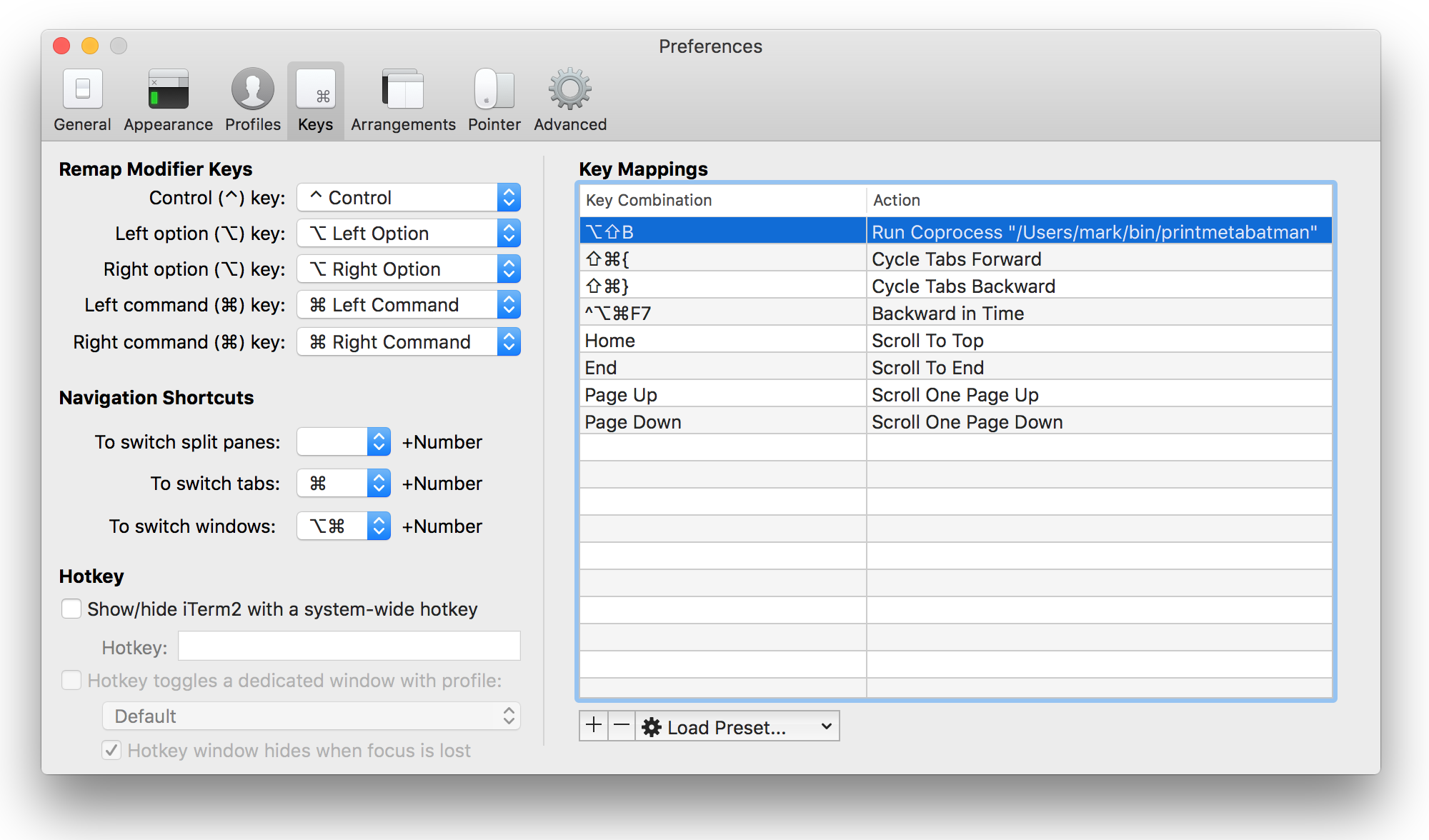
Making an OS X Service
What if we want to take it even further? Have a keyboard shortcut that doesn't insert the text in a particular application but inserts the text anywhere on OS X that OS X thinks it can take text input?
OS X Services are global menu items that can be triggered by clicking on the title of the current running application next to the apple logo in the top left corner of the screen and selecting them from the Services menu underneath. More importantly, they can also be assigned global keyboard shortcuts.
The Automator application that is provided by Apple can be used to create Services that run Perl scripts: Launch Automator and select "Service" to create a new service. Search for the Run Shell Script action then configure it to run the Perl script (you can write Perl code directly in this box and configure it to be executed with /usr/bin/perl, but we're re-using the same script as in the previous examples.) Finally set it so the Service takes no input and tick the box so that Output replaces selected text.
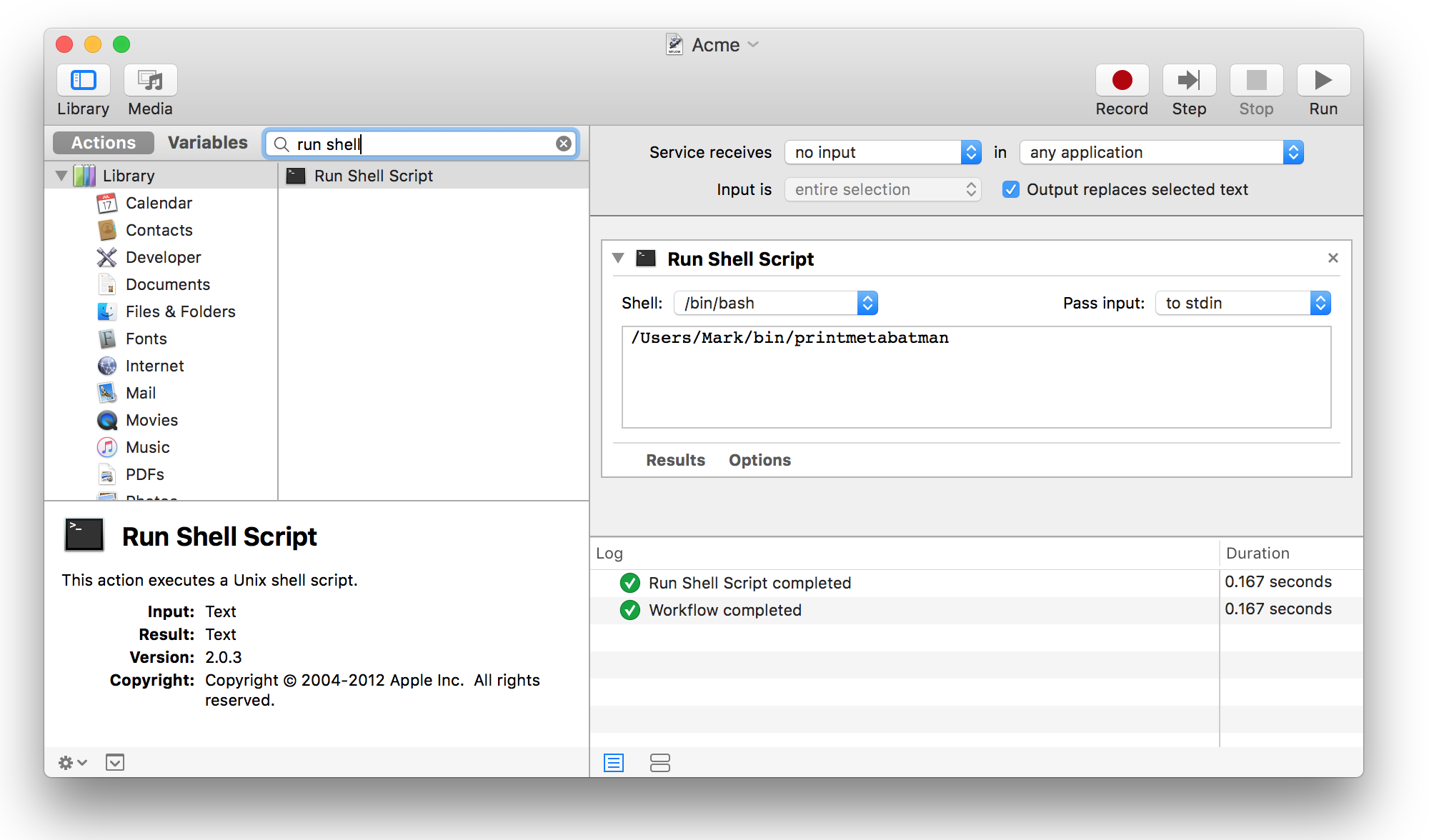
The service is installed as soon as you save it.
Once you have created the service you can then assign a keyboard shortcut to it in System Preferences. Select the Keyboard icon, click on the Shortcuts tab and then pick Services on the left. Scroll down till you find your service under Text and click on the space to the right of the name to assign the shortcut.
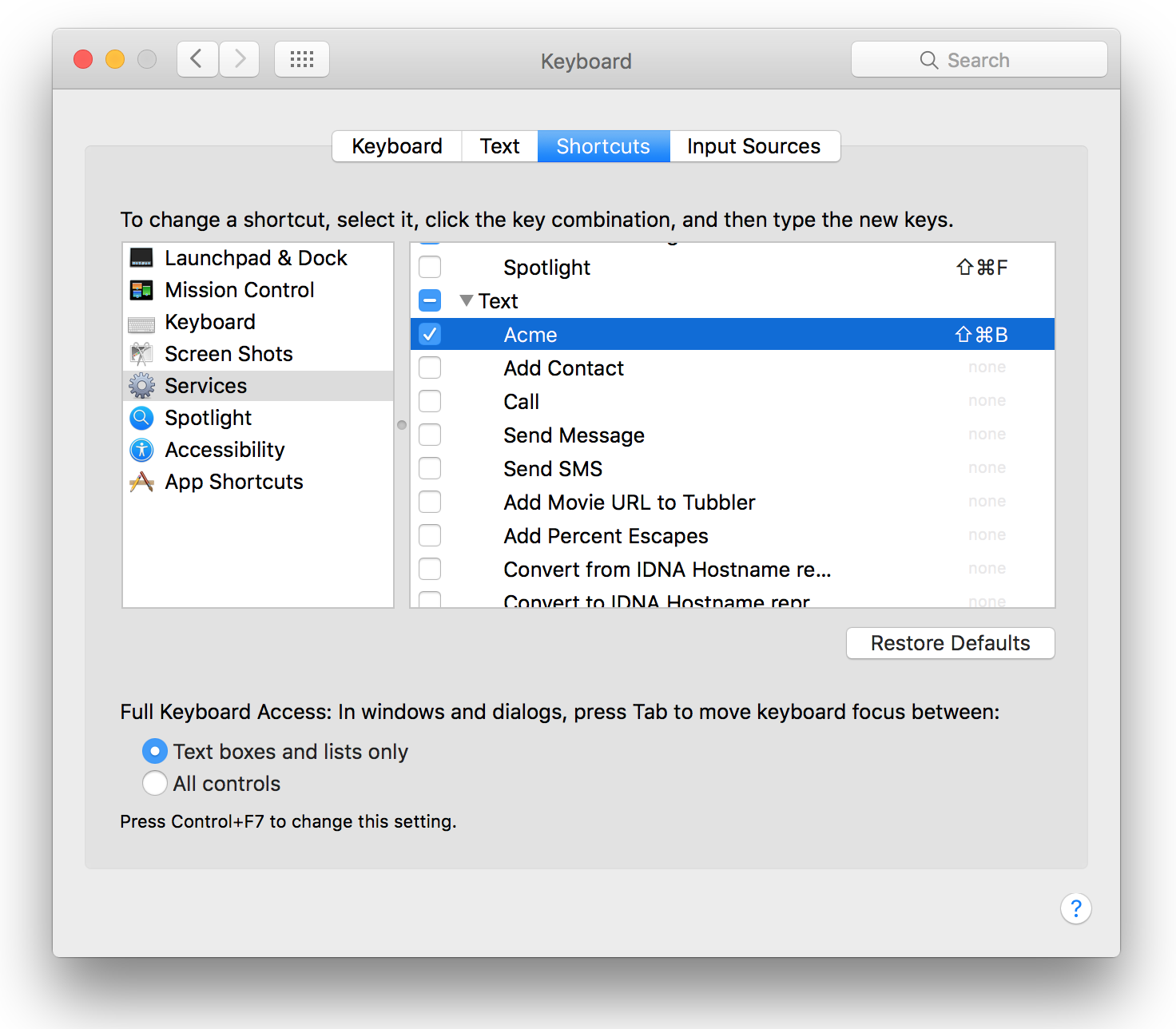
Keyboard Maestro
If you were paying close attention you'll notice that previously I said that a service can be used "anywhere on OS X that OS X thinks it can take text input". What does that mean? It means that they can be used anywhere that the application is using the standard libraries to create a text input area. But not all applications use that (for example the previously mentioned iTerm2 and Sublime Text don't use those, and the service cannot be used within them.)
Keyboard Maestro is a commercial utility that can be used to control your Mac. One of the many things it can do is trigger a workflow whenever a key combination is pressed. That workflow can execute an external script and Keyboard Maestro can then simulate the keys on your keyboard being pressed. This means that the output from that script can be typed anywhere in any application running on your Mac, whether or not it's explicitly expecting it.

Typing Autocompletion
Another option to insert the text is to use a text expansion utility. For example, using the TextExpander program I can configure my computer so that every time I type metaqq it deletes that text and quickly types the output of my Perl script:

Setting this kind of script up with TextExpander is trivial; You just create a new macro and click on the content header and select Shell Script then enter the path to our existing script in the shebang line (or, you could write the Perl shell script here, directly in the text box.)

Keyboard Maestro is a little more complex to use than Text Expander but can also be configured to do text expansion with a shell script. It can even be configured to match what typed text triggers the macro with regular expressions, which allows you to have a very crude way to type in variables. For example, to produce a macro where we can type meta<theme>qq to select any of the installed Acme::MetaSyntactic themes:
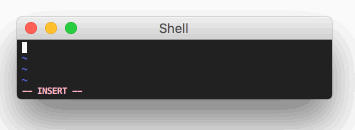
In order to work out what was typed in the script we need to set a variable to the %TypedText% temporary variable, and then access it via an environment variable in our Perl script:
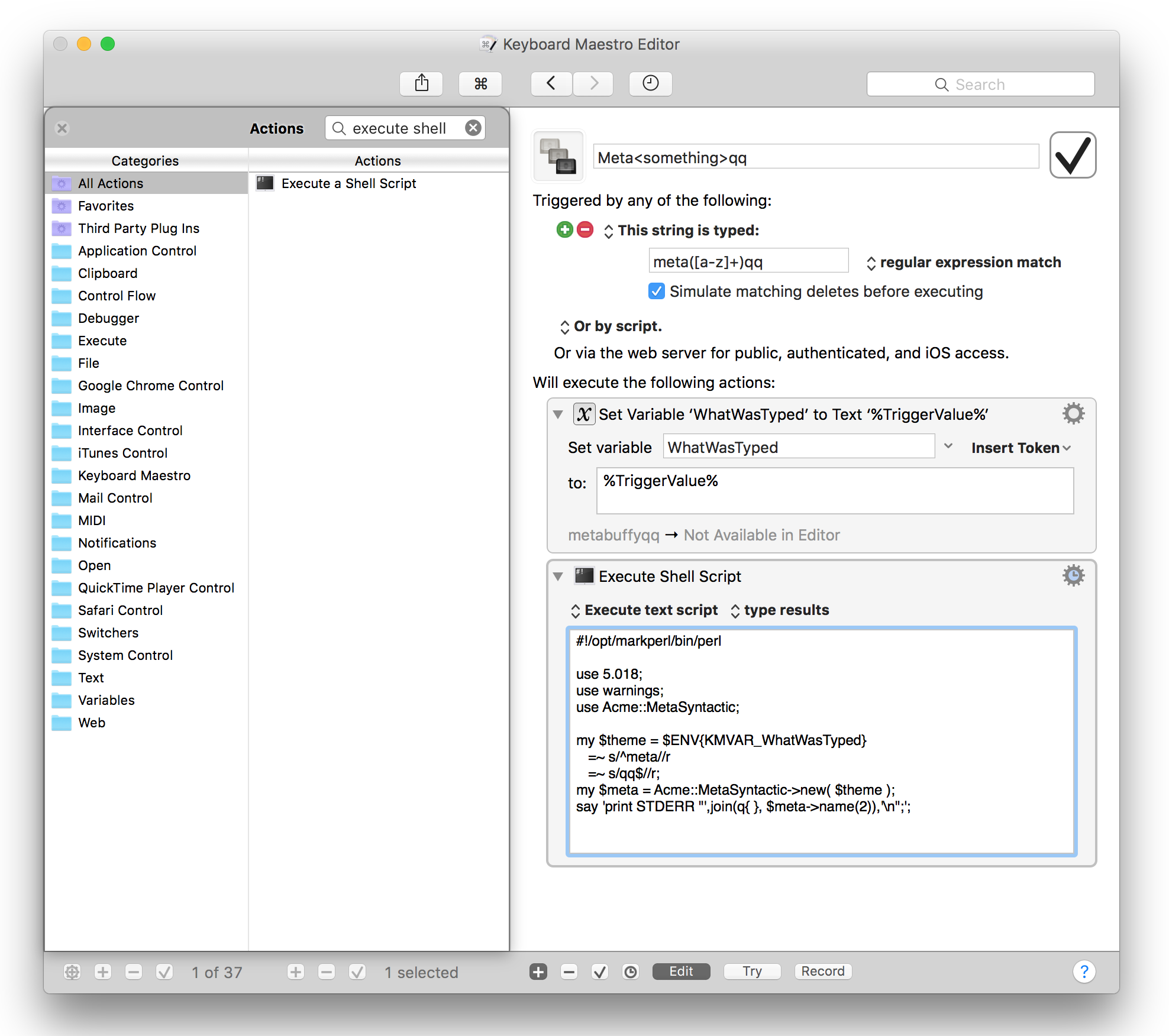
The True Perl Laziness
So today we have truly embraced the Perl concept of laziness. Rather than have to spend five seconds typing in a print statement, we've developed a Perl script that generates suitable output for us and investigated at least six different ways to trigger it on a Mac. I'm sure you'll all agree that that's time well spent.
swish bloop ker_sploosh thwape aiieee!